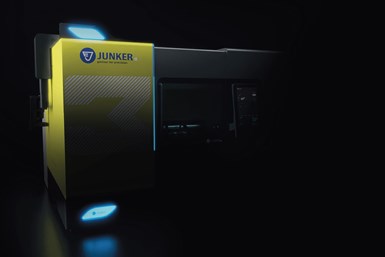Junker Grinding Machines Feature Modular Design
The Platform 3 series of modular grinding machines is designed to provide increased flexibility and cost-effectiveness.
Share





Junker’s Platform 3 series of modular grinding machines were developed to provide smaller lot sizes and greater part variety. The new Junicor covers all conventional grinding requirements, while high-speed grinding machines such as the Jumat, Jucam, Quickpoint and Jucrank feature CBN and diamond grinding wheels. This series of high-performance grinding machines is well suited for producing individual parts in small batches and larger workpiece series.
The new series of machines are designed to provide increased flexibility and cost-effectiveness in a modular system. A wide range of standard and custom-made configuration options are available, including individual table assemblies and grinding spindle heads. Depending on accuracy, customers can choose between different guiding and driving systems on both main axes, X and Z.
Platform 3 features integrated automation. The internal gantry loading system can quickly adapt to new workpiece configurations with little effort and ensures smooth workpiece handling, according to Junker. The system provides easy access to all components on the outside and inside of the machine, combined with optimized setup capability. The grinding machines feature various wheel-head variants, with or without an automatically swiveling B-axis. Up to three grinding spindles can be mounted on one single wheel head.
Other features Junker offers include short delivery times and reduced throughput of machines and components; guaranteed spare parts availability; reduced service and repair times; flexible retooling for second and third product life cycles; high repeatability and rigidity; optimal thermal stability; and a compact machine footprint.
Platform 3 enables a wide range of grinding processes, such as cylindrical or non-cylindrical grinding for OD and ID applications, plunge and angular plunge grinding, complex operations such as profile, face, surface and groove grinding, as well as the traditional Junker Quickpoint grinding/peel-grinding process.
Related Content
-
How to Successfully Adopt Five-Axis Machining
While there are many changes to adopt when moving to five-axis, they all compliment the overall goal of better parts through less operations.
-
Orthopedic Event Discusses Manufacturing Strategies
At the seminar, representatives from multiple companies discussed strategies for making orthopedic devices accurately and efficiently.
-
Inside a CNC-Machined Gothic Monastery in Wyoming
An inside look into the Carmelite Monks of Wyoming, who are combining centuries-old Gothic architectural principles with modern CNC machining to build a monastery in the mountains of Wyoming.

























